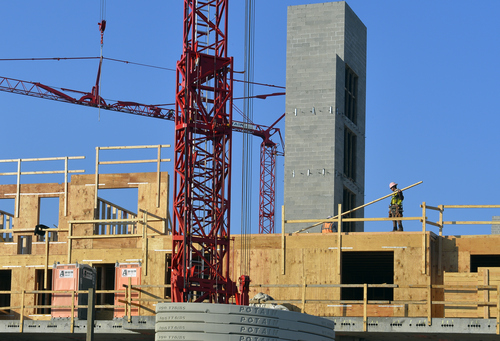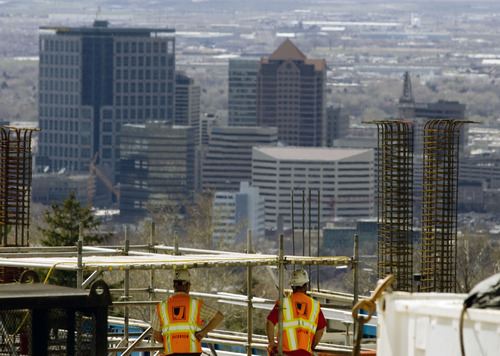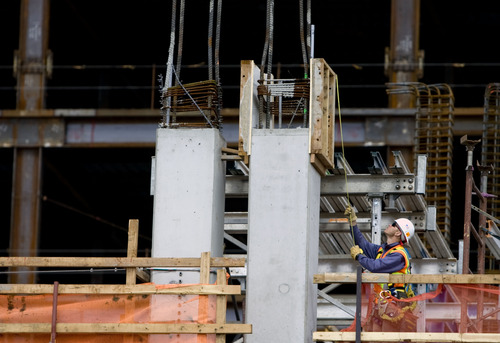This is an archived article that was published on sltrib.com in 2014, and information in the article may be outdated. It is provided only for personal research purposes and may not be reprinted.
Building contractors in Utah plan to hire workers and are among the most optimistic in the country about demand for new workers in 2014, a new survey suggests.
Poll numbers for builders in Utah and across the nation, published Tuesday by the Associated General Contractors of America, are some of the most upbeat since the housing bust and the Great Recession, which hit Utah's construction sector especially hard.
"Contractors are more optimistic about 2014 than they have been in a long time," Stephen Sandherr, the association's chief executive, said. The industry has a long way to go to reach levels it saw in the middle of the past decade, Sandherr said, but "conditions are headed in the right direction."
The survey, which does not cover single-family residential building sectors, questioned 800 firms across the country.
Respondents in Utah point to an especially robust outlook for new building of highways and manufacturing facilities, as well as retail, warehouse and lodging projects. And in another harbinger of recovery, the state's contractors said they're more likely to lease or buy new equipment in 2014, compared with past years.
Some of Utah's leading contractors even are predicting modest wage gains for construction workers and already foresee difficulty in filling openings for skilled workers and trade specialists into 2015, as a recovery of employment in the state's battered building sector takes hold.
Wages are picking up after staying flat from 2008 through the economic downturn, the head of one of Utah's largest general contractors said.
"What the industry is doing now is just catching up," said Rob Moore, president of Salt Lake City-based Big D Construction. "The pressure we're having is just keeping the workers we need in the industry."
The sector has lost nearly 25,000 workers, down from a peak of more than 100,000 during Utah's construction heyday, Moore noted.
"The fear is what's going to come next, as we head into 2015 and what we think will be the light at the end of the tunnel," he said. "With demand for more projects, where are those workers going to come from? Are they skilled? Are they working in other market sectors now?"
Those concerns are mirrored at the national level, as nearly two-third of contractors report having trouble hiring the people they need, said Ken Simonson, the association's chief economist. Nearly half of poll respondents said training programs for new workers were inadequate, Simonson noted.
The happier outlook for construction demand in Utah represents a turnaround from just one year ago.
Higher percentages of Utah builders reported laying off workers in 2013 and fewer hired new employees than their national counterparts, the survey found. Those layoffs tended to be larger both in number and in share of total company work force than the national average.
But contractors in the state are now more optimistic than those surveyed in 19 other states that they will hire this year and be less likely to let workers go. They are also more optimistic 2014 will bring a significant rebound in activity than their national counterparts, who tended to believe the rebound wouldn't come until 2015 or beyond.
Industry groups in Utah report an upswing in demand for new office, retail and especially warehouse and industrial construction. There has been something of a surge in demand for new distribution centers in Utah, reflecting both the state's central location geographically and new federal limits on hours truckers can drive without rest.
Though not included in the poll numbers, residential construction also started to pick up in Utah over the summer, as sales and prices rose, inventories of available homes fell and firms announced a wave of new of housing starts.
But notably, Utah builders were significantly less optimistic about demand for new water and sewer projects than builders elsewhere, reflecting caution about the rebound in tax revenue for state and local government.







